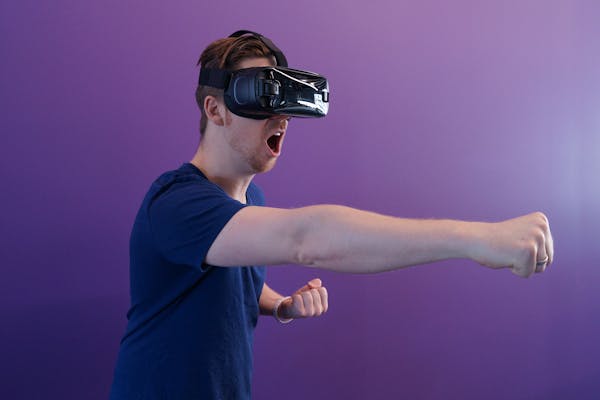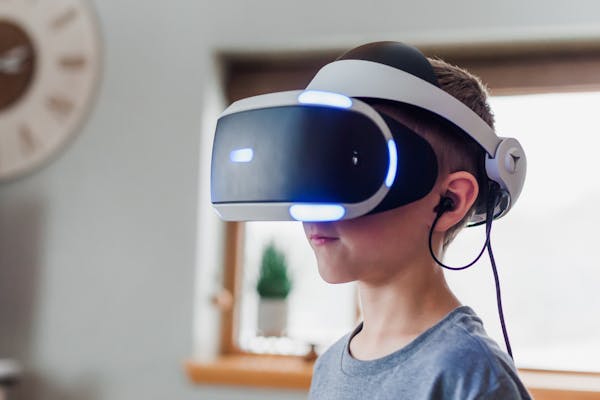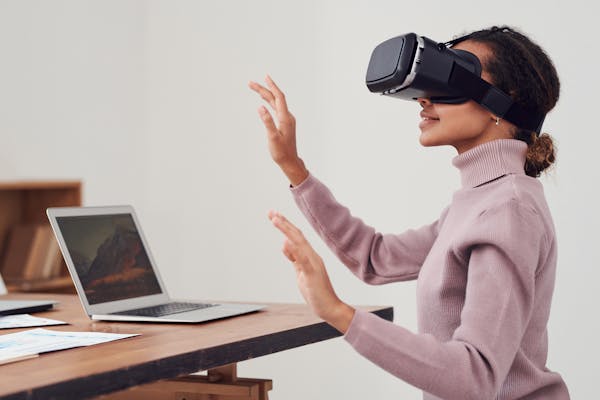Virtual reality (VR) has evolved dramatically since its inception, transitioning from science fiction concepts to a transformative technology that impacts various sectors, including entertainment, healthcare, education, and business. As VR technologies have advanced, the immersive experiences they offer have broadened, providing users with the ability to experience alternate realities that closely mirror—or even improve upon—their real-world environments. Among the numerous applications, the benefits of virtual reality stand out, making it one of the most innovative tools of the 21st century.

The Evolution of Virtual Reality
Virtual reality as we know it today was not developed overnight. It was the result of decades of innovation and experimentation. The history of VR can be traced back to the mid-20th century, with early attempts at creating immersive, artificial environments. One of the first examples was Morton Heilig’s 1962 invention of the “Sensorama,” a device that gave users a multi-sensory experience with visuals, sound, vibration, and even smell.
In the 1980s, technological progress began to gain momentum with the creation of more sophisticated VR headsets. Jaron Lanier, who coined the term “virtual reality,” founded VPL Research in 1985 and developed some of the earliest VR gear, including the Data Glove and the EyePhone (not to be confused with Apple’s iPhone). Over the next few decades, the introduction of more powerful computers, better graphics, and refined input devices paved the way for the immersive VR experiences we have today.
In 2012, Oculus VR, founded by Palmer Luckey, introduced the Oculus Rift prototype, which kickstarted modern VR development. This leap forward in technology inspired a new generation of VR devices from major companies such as HTC (with the HTC Vive), Sony (PlayStation VR), and Valve (with the Valve Index). By the mid-2010s, VR had firmly established itself in the consumer market, setting the stage for wider adoption.
The Technology Behind Virtual Reality

At its core, virtual reality is about creating a computer-generated environment that users can explore and interact with in real time. To accomplish this, VR relies on a combination of hardware and software components that work together to create immersive, interactive experiences.
Hardware Components
VR systems typically consist of the following hardware elements:
- Headsets: A VR headset (often referred to as head-mounted display or HMD) is the most recognizable piece of VR hardware. These devices feature stereoscopic displays that project separate images for each eye, creating the illusion of depth. Headsets also include tracking systems that monitor the user’s head movements, adjusting the perspective accordingly to ensure a fully immersive experience.
- Controllers: VR controllers allow users to interact with virtual environments. These often include motion sensors to detect hand movements, as well as buttons, joysticks, and haptic feedback to provide a tactile experience.
- Tracking Systems: External sensors or inside-out tracking (built into the headset) track the user’s position and movement within a 3D space. This tracking ensures that the virtual world responds to the user’s actions in real-time.
- Tactile and Haptic Feedback Devices: Some advanced VR systems integrate haptic devices that allow users to “feel” their interactions within the virtual environment. This enhances the immersive experience by adding a sense of touch.
Software Components
On the software side, VR environments are generated using sophisticated 3D graphics and physics engines. VR software is responsible for rendering the virtual world, processing user inputs, and providing real-time feedback. This software often includes:
- 3D Engines: Programs such as Unity, Unreal Engine, and CryEngine allow developers to create lifelike virtual worlds, complete with lighting, textures, and realistic physics.
- Content Creation Tools: VR experiences require unique, interactive content, often developed using specialized software tools for modeling, animation, and interaction design.
- Motion Processing Algorithms: These ensure that the user’s physical movements in the real world correspond accurately to movements within the virtual environment.
The convergence of these technologies creates an immersive experience that allows users to enter fully realized digital worlds, opening up a wealth of new opportunities.
The Benefits of Virtual Reality

Virtual reality is vast and transformative, influencing everything from entertainment and gaming to healthcare, education, and business. The following sections explore how VR is changing different industries and the specific advantages it brings to each.
Benefits of Virtual Reality in Entertainment and Gaming
Perhaps the most well-known use of VR is within the entertainment and gaming industries. Virtual reality provides an immersive experience that allows players to feel as though they are part of the game world, offering a level of interactivity and engagement that traditional gaming cannot match.
- Immersive Experiences: VR provides unparalleled immersion, placing users directly into the action. This can be particularly impactful in gaming, where players can look around, move through, and interact with the game world in a more lifelike way.
- Social Interaction: Multiplayer VR games allow users to interact with others in real-time, adding a new layer of social connectivity. These interactions feel more natural and personal than traditional online multiplayer experiences because avatars move and gesture like real people.
- Unique Storytelling: In VR, players can engage with stories from a first-person perspective. This offers new forms of interactive storytelling, where the user’s decisions directly impact the narrative.
Beyond gaming, VR is also making waves in the film industry. Virtual reality cinema allows audiences to experience stories from within, providing a new frontier for filmmakers to explore innovative storytelling techniques.
Benefits of Virtual Reality in Healthcare
One of the most significant benefits of virtual reality lies in the healthcare sector. VR is being used in a wide variety of medical applications, from training and education to treatment and rehabilitation.
- Medical Training: VR provides a safe and controlled environment for medical professionals to practice complex procedures. Surgeons, for instance, can use VR to simulate surgeries, honing their skills without any risk to real patients.
- Therapeutic Uses: VR is being used in therapy to treat conditions such as post-traumatic stress disorder (PTSD), anxiety, and phobias. For example, exposure therapy in VR allows patients to confront their fears in a safe, controlled environment, helping them build resilience.
- Pain Management: VR is also being explored as a tool for pain management. By immersing patients in calming virtual environments, VR can help distract them from pain and anxiety during medical procedures.
- Rehabilitation: Virtual reality is proving valuable in physical rehabilitation, particularly for patients recovering from strokes or traumatic injuries. VR exercises can be tailored to individual patients’ needs, providing engaging and motivating therapy sessions.
The potential for VR in healthcare is immense, with researchers continually discovering new ways in which the technology can improve patient care and outcomes.
Benefits of Virtual Reality in Education
The education sector is another area where VR is making a significant impact. The benefits of virtual reality in education include enhancing engagement, improving understanding, and providing access to experiences that would otherwise be inaccessible.
- Immersive Learning Environments: VR can transport students to different times and places, from historical reenactments to distant planets. This immersive approach to learning can make lessons more engaging and memorable.
- Simulations: Students in fields such as engineering, architecture, and science can benefit from VR simulations that allow them to experiment and learn in a virtual environment. This hands-on approach helps students understand complex concepts more effectively.
- Accessibility: VR can provide educational opportunities for students in remote or underserved areas, giving them access to high-quality, immersive learning experiences that would otherwise be unavailable.
- Language Learning: VR environments are also being used for language learning, allowing students to practice speaking in realistic virtual settings. This can help improve fluency and confidence in a way that traditional classroom instruction cannot.
Virtual reality has the potential to revolutionize education, providing students with interactive, engaging experiences that can enhance learning and retention.
Benefits of Virtual Reality in Business and Industry
The business world is increasingly recognizing the benefits of virtual reality for training, collaboration, and customer engagement. VR is helping businesses streamline operations, enhance productivity, and improve employee training.
- Training and Development: VR is being used to train employees in various industries, including manufacturing, retail, and customer service. Virtual simulations allow employees to practice skills in a risk-free environment, improving their confidence and competence.
- Collaboration and Remote Work: As remote work becomes more prevalent, VR is being used to facilitate collaboration between teams across the globe. Virtual meeting spaces allow team members to interact in a more lifelike way than traditional video conferencing.
- Product Design and Prototyping: VR is transforming the design and prototyping process, allowing designers and engineers to create and test products in a virtual environment before they are built. This can save time and money by identifying potential issues early in the design process.
- Customer Engagement: Businesses are also using VR to engage customers in new and exciting ways. For example, car manufacturers are offering virtual test drives, and real estate agents are providing virtual property tours. These immersive experiences can enhance customer satisfaction and drive sales.
Benefits of Virtual Reality in Mental Health and Wellbeing
Beyond its practical applications, VR is also being explored for its potential to improve mental health and wellbeing. The immersive nature of VR allows users to experience calming or uplifting environments, which can have therapeutic benefits.
- Stress Reduction: VR environments are being designed to promote relaxation and reduce stress. By immersing users in tranquil virtual spaces, such as beaches or forests, VR can help alleviate anxiety and promote mindfulness.
- Emotional Support: Virtual reality can provide emotional support for individuals dealing with loneliness or social isolation. VR social platforms allow users to connect with others in a more personal and engaging way than traditional social media.
- Cognitive Behavioral Therapy: VR is being used in cognitive-behavioral therapy (CBT) to help patients reframe negative thoughts and behaviors. By simulating real-world situations, VR can provide a safe space for patients to practice coping strategies.
The mental health applications of VR are still in their early stages, but the potential for positive outcomes is clear.
Challenges and Future Directions for Virtual Reality
While the benefits of virtual reality are extensive, the technology is not without its challenges. Some of the obstacles to widespread VR adoption include:
- Cost: High-quality VR systems can be expensive, which can be a barrier to entry for some users and businesses.
- Accessibility: Not everyone can use VR comfortably. Some users experience motion sickness or discomfort during extended use, which can limit the technology’s accessibility.
- Content Development: Developing VR content is time-consuming and requires specialized skills. Creating high-quality, immersive experiences can be resource-intensive.
- Hardware Limitations: While VR hardware has improved significantly, there is still room for advancement in terms of resolution, processing power, and portability.
Despite these challenges, the future of virtual reality looks bright. As technology continues to evolve, we can expect VR to become more affordable, accessible, and integrated into everyday life. Advances in areas such as haptic feedback, eye-tracking, and AI will further enhance the immersive experience, making VR even more impactful.
Virtual reality is no longer just a futuristic concept; it is a rapidly growing field that is transforming industries and improving lives. From healthcare and education to entertainment and business, the benefits of virtual reality are undeniable. As technology continues to advance, we can expect VR to play an even larger role in shaping the future, offering new possibilities for learning, working, and connecting with the world around us. Whether through immersive gaming, life-saving medical applications, or innovative business solutions, virtual reality is poised to revolutionize how we interact with both digital and physical worlds.





